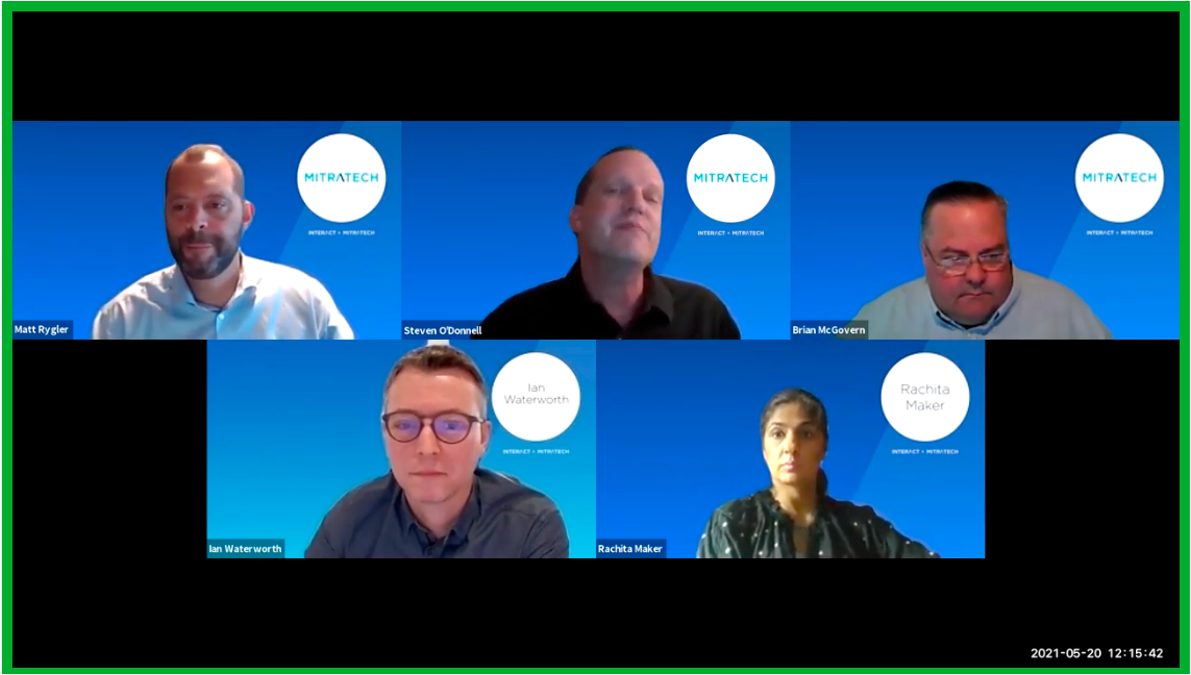Legal tech adoption is a brave new world for many legal departments. What lessons can we learn from those who have already taken the plunge?
Mitratech hosts Steven O’Donnell, Head of Product Marketing – Legal Operations, Brian McGovern, General Manager for Workflow Automation, and Matt Rygler, Global Strategic Account Manager for ELM in EMEA, had the pleasure of sitting down for a (virtually) interactive roundtable, The Community that Co-Innovates – A Legal Operations Roundtable, with a panel of experts on the potential (and potential pratfalls) involved in legal tech adoption.
Rachita Maker heads up legal operations and compliance for global giant Tata Communications; Ian Waterworth is Head of Programme and Change at Standard Chartered Bank, and Libbie Evans is Associate VP Knowledge Management for TD Bank.
We had plenty of questions and touched on a variety of subjects, from choosing the right workflow automation tool to technology adoption and challenges. Here’s a sneak peak into what was covered, but tune into the whole video for some revealing insights and shared experiences from these legal ops leaders.
On implementing workflow automation
Brian McGovern: How did you come up with your goal of modernizing legal technology, and how are you thinking about developing your roadmap and plan, especially around workflow automation?
Rachita Maker: When I first joined, my GC’s mandate to me was clear and simple – make the legal department state of the art. No pressure!
So we wanted to look at some quick wins…I thought the best way was to go with workflow automation and to look at some of the manual processes that take up so much time and can be easily automated. With some of the other processes, you have to bring in a lot of stakeholders, get buy-in from different people in the organization, and that takes a lot more time.
Brian McGovern: So what were the key things that you wanted from a workflow automation tool? What was your site selection criteria, and what did you learn in that process?
Rachita Maker: One of the key things that was the selling point for me was the ability to control the workflow automation tool, without having to depend on an outside vendor or my internal IT teams, or anyone else. My team is multidisciplinary; I have lawyers on my team, I have process experts, some tech people, some data analytics people…for me it was very important to have the ability to quickly change things and to be able to control the tool.
The fact that my team can go in, build forms, create workflows, and 80-85% of the work can be easily done by a person who has no experience coding? That was the key.
Of course, the flexibility of the automation tool was the other aspect – (we were) asking questions like, how easily can we look at our processes? And how does it adapt to different processes?

Lawyers and legal tech adoption
Libbie Evans: I think lawyers sometimes lack confidence in how well the technology is going to work and they feel like at the end of the day, they’re accountable for what’s delivered, and if the technology doesn’t work that makes their job even harder. So if they don’t have confidence and trust in the tool from the get-go, they might just say ‘look, I’m going to get this done myself and it’s going to be easier and safer for me.’ So it’s important not to give them tools that don’t work. Or at least, coach them through that, because of course nothing’s perfect, but at least coach them.
Ian Waterworth: I agree, you’re absolutely right, I think you know it’s not going to be perfect at first. And in my experience, there’s a lot to technology that isn’t utilized – or is underutilized, to begin with. So you only use a small portion of its expected benefits at the beginning.
I think a lot of people have the perceived idea that it’s going to change everything and it’ll be perfect on day one, but the truth of the matter is a lot of times it isn’t, and it needs time to evolve.
It’s also important not to forget the users – don’t leave them behind because it can be something that becomes a very quick source of frustration and then you start turning people off. You need to allow time in your strategy roadmap to be able to cater to those burning issues or problems that people feel need to be addressed.
After your product goes live, you can’t just stick to your roadmap…go hell-for-leather and forget everyone else. You’ve got to allow time for them, to make sure that you bring them along with you. If there are things that are important to them, you address them, and you slowly but surely build that trust and that journey with them.
It’s also important not to forget the users – don’t leave them behind because it can be something that becomes a very quick source of frustration.
Watch Every Day of Interact EMEA 2021 On Demand
View every recorded session, featuring legal, risk & compliance pundits, for free!


